Croatia on an uptrend, housing market strong
Croatian house prices continue to rise, mainly fuelled by strong demand, coupled with limited housing supply. Demand is surging. In 2018, the total number of new dwellings sold rose by 18.6% to 2,880 units from a year earlier.
In 2018, the nationwide price index for all dwellings rose by 4.69% (3.77% inflation-adjusted) from a year earlier, after y-o-y increases of 7.64% in 2017 and 0.79% in 2016. During the latest quarter dwelling prices increased 1.09% (1.48% inflation-adjusted).
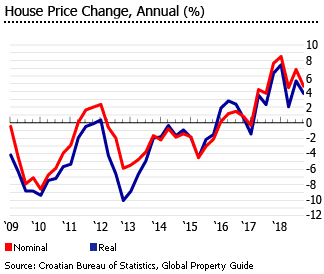
The house price index in Zagreb, Croatia’s capital and largest city, soared 8.47% (7.51% inflation-adjusted) in 2018, according to the CBS. The average price of new dwellings in Zagreb, which accounts for more than 45% of all sales transactions in the country, stood at HRK 12,749 (€1,712) per square metre (sq. m) in 2018.
On the Adriatic Coast, house prices rose by 4.44% (3.52% inflation-adjusted) y-o-y in 2018.
In other areas of the country, house prices fell slightly by 0.25% (-1.14% inflation-adjusted).
During 2018:
- New dwellings: the price index rose by 2.8% y-o-y (1.88% inflation-adjusted)
- Existing dwellings: the price index rose by 5.02% y-o-y (4.08% inflation-adjusted)
Before the recent surge there was a long period of declining house prices - 2.13% in 2015, 1.44% in 2014, 1.68% in 2013 and 5.88% in 2012, according to the Croatian Bureau of Statistics (CBS).
Croatia’s property market is expected to remain strong in the coming years, thanks to robust demand supported by healthy economic growth.
“We expect the prices will continue (slightly) increasing in the short to medium term in Zagreb and on the coast, providing the interest rates and economic cycle remain stable,” said Colliers International.
On January 1, 2017, Croatia lowered real estate transfer tax from 5% to 4%. On VAT-charged property transactions, the VAT rate remains 25%.
The right of non-EU foreign nationals to buy a property in Croatia depends on reciprocity agreements between Croatia and the foreign buyer’s home country.
The Croatian economy expanded by a modest 2.6% in 2018, according to the Croatian Bureau of Statistics (CBS), mainly driven by strong private consumption, supported by rising wages and employment. The economy is expected to grow by 2.7% this year and by another 2.6% in 2020, based on European Commission estimates.
Foreign buyers flock to the coast
Croatia’s high-end residential market continues to attract foreign buyers. About 70,000 foreigners own property on the Adriatic Coast. Only 3% of foreign buyers chose Zagreb City.
Of Croatia’s 20 regions, the five most popular with foreign buyers are on the Adriatic Coast:
Istria (33% of foreign-owned properties), Primorje-Gorski Kotar (26%), Split-Dalmatia (12%), Zadar (8%), and Dubrokniv-Neretva (6%).

Around 55% of approved permits for foreign acquisitions were granted to Germans. Austrians come in second place with 16% of permits granted, followed by Britons (6%), Hungarians (4%) and Dutch (3%).
Luxury properties in Istria are popular among Germans, Austrians, and Slovenians. In Dalmatia, most luxury demand comes from the Croatian diaspora: Sweden, Slovakia, and the Czech Republic. Luxury homebuyers in Opatija are mostly Russians.
In the past two years, no new large-scale tourist resorts have been built. Most development were small projects, usually waterfront projects with up to 10 units or less. These small-scale projects are mostly in Dalmatia (the islands of Brač and Hvar, Makarska Riviera, and Rogoznica) and in Kvarner region’s Krk Island.
However a new retreat resort at Brizenica Bay, in the island of Hvar, is to be built featuring a 120-key Four Seasons hotel and around 60 high-end properties. This resort development from Arqaam Capital and Four Seasons is expected to open this year.
Hvar Star Residence company also recently unveiled a mixed use development to be built at Maslinica Bay. The project includes private villas, a resort and luxury hotel suites.
Demand for property is everywhere strong
Demand is surging, thanks to strong local and foreign demand. In 2018, the total number of new dwellings sold in Croatia rose by 18.6% to 2,880 units from a year earlier, according to the CBS. Likewise, the total area of new dwelling sales was up 18.7% y-o-y to 196,272 sq. m.
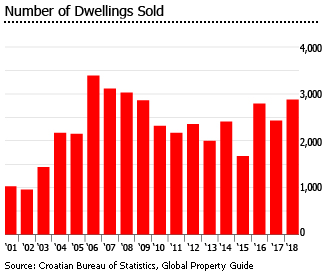
Over the same period:
- In Zagreb, the number and area of new dwellings sold rose by 19.9% and 29%, respectively;
- Elsewhere the number of new dwelling sales rose by 17.5% while the area sold increased 10.8%.
Residential construction falling after 2 boom years
Dwelling permits fell by 6.3% to 11,719 units in 2018, following strong growth of 33.1% in 2017 and 35.2% in 2016, according to the Croatian Bureau of Statistics. Likewise, the total floor area of dwellings for which permits were issued dropped 3.2% y-o-y to 1.13 million square meters.
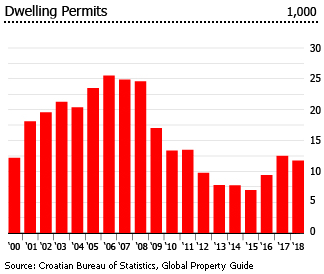
From 2001 to 2008, dwelling permits averaged 22,000 units annually. After the 2008 crisis, dwelling completions and permits fell even below levels seen during the War of Independence (1991-1995).
Moderate to good rental yields in Zagreb, but very limited rental market
Gross rental yields in Croatia’s capital, Zagreb, are moderate to good, ranging from 5.4% to 6.1%, based on Global Property Guide research. In Split, rental yields are lower, at around 3.2% to 4.7%. Smaller-sized apartments tend to have higher yields than larger ones.
Most Croatians are owner-occupiers. About 90.5% of Croatian households are currently living in an owner-occupied home or apartment, according to the Eurostat.
The Adriatic coast is the core of short-term demand, concentrating on short-term holiday rentals for foreigners and tourists.
The country’s long-term rental market is very small. Most long-term rental properties are in Zagreb, Dubronik, and Split. In Zagreb, the demand for rental properties partly comes from students studying at the University of Zagreb, as in Split, where the greatest demand is in the city centre and around the university campus.
According to Global Property Guide research:
In Zagreb a 90 sq. m. apartment rents for around HRK 6,459 (€870) per month; while a 120 sq. m. apartment is offered for around HRK 7,973 (€1,074) per month.
In Split a 120 sq. m. apartment rents for around HRK 6,199 (€835) per month.
Mortgage interest rates are now really low
In February 2019, the average interest rate for housing loans indexed to foreign currency stood at 3.29%, down from 3.55% in February 2018 and 3.91% in February 2017, according to the Croatian National Bank (CNB), the country’s central bank.
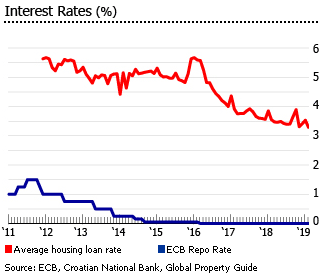
Rates for housing loans indexed to foreign currency (February 2019):
- Floating rate and interest rate fixation (IRF) of up to 1 year: 3.6%, down from 3.76% a year earlier
- IRF over 1 and up to 5 years: 3.3%, down from 3.54% a year earlier
- IRF over 5 years and up to 10 years: 3.16%, down from 3.36% in the previous year
- IRF over 10 years: 3.47%, down from 3.63% a year earlier
Rates for housing loans not indexed to foreign currency:
- Floating rate and IRF of up to 1 year: 3.58%, down from 3.86% in February 2017
- IRF over 1 and up to 5 years: 3.57%, down from 3.84% a year ago
- IRF over 5 years and up to 10 years: 3.06%, down from 3.84% a year ago
- IRF over 10 years: 3.39%, down from 3.88% a year earlier
Only about 11% of all new housing loans in February 2019 are floating rate (or with interest rate fixation (IRF) of up to 1 year), an unusually small proportion. In fact more than 72% of all new housing loans have an IRF of more than 5 years. This suggests that the Croatian property markets will be exceptionally resilient in the event of interest rate hikes.
Mortgage loans are rising again, after years of decline
After six years of massive contraction, Croatia’s outstanding housing loans expanded again by about 2.3% in 2018. Since 2012 outstanding housing loans have been declining, even after the economy recovered from recession in 2015, contracting by 0.6% in 2012, 1.9% in 2013, 2% in 2014, 1.9% in 2015, and 11.1% in 2016, according to the CNB. In 2017, housing loans grew by a meagre 0.6%.
This decline came despite the fact that Croatia’s mortgage market has developed significantly during the past decade. The old large state-owned banks have been privatized, and commercial banks have been restructured. Austrian, Italian and German banks have entered the market. There was a significant increase in building societies’ share of loans, from 1% in 2003 to 5% recently.

The loan market is now recovering, helped by very low interest rates. One interesting trend has been the rise of kuna-denominated loans in the past two years. From a share of below 10% of the total outstanding housing loans from 2010 to 2015, the share of kuna-denominated housing loans not indexed to foreign currencies rose to to 25.9% in 2017 and to 28.4% in 2018, according to the CNB. In February 2019, Kuna loans not indexed to foreign currencies surged 10.6% y-o-y while foreign-currency indexed loans increased by a miniscule 0.6%. Kuna-denominated new housing loans now amount to HKR 330.1 million (€44.39 million), while foreign currency-indexed kuna loans amount to HRK 569.3 million (€76.55 million).
According to Igor Ljubaj and Suzana Petrović of the CNB the rise of kuna loans was due to:
- The decline of interest rates on kuna loans as a result of the drop in the general level of interest rates;
- Households’ negative experience with Swiss franc-indexed loans
- CNB regulatory changes that raised the consumers’ awareness about currency risk;
- Strong competition among banks granting new loans, and
- Banks’ reduced reliance on foreign currency financing.
Modest economic growth; improving national finances
The Croatian economy expanded by a modest 2.6% in 2018, according to the Croatian Bureau of Statistics (CBS), mainly driven by strong private consumption, supported by rising wages and employment.
“Private consumption is expected to remain the main driver of growth, supported by improving labour market conditions, positive consumer sentiment, low interest rates and subdued inflation,” said the European Commission.
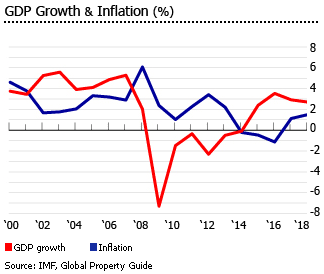
Croatia’s economy is expected to expand by 2.7% this year and by another 2.6% in 2020, according to the European Commission.
From 2009 to 2014, Croatia’s economy lost more than 12% of GDP, Europe’s second-biggest contraction after Greece. Since the beginning of 2014, Croatia has been in the European Commission’s Excessive Deficit Procedure (EDP) due to its high budget deficits and public debt.
Croatia’s economy began to turn around in 2015 and gained momentum in 2016, expanding by 2.3% and 3.5%, respectively. The country exited the EDP in June 2017.
Croatia’s public debt stood at 74.5% of GDP in 2018, down from 84% in 2014. There was a budget surplus in 2018 for the second year in a row since independence, supported by higher tax revenues and expenditure savings.
Standard & Poor’s (S&P) raised Croatia’s credit rating to ´BBB-/A-3´ from ´BB+/B´ in March 2019, putting the country back into the investment category after six years.
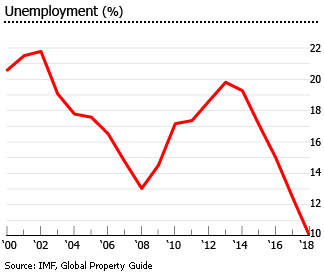
Croatia’s most serious problem is high unemployment, the fifth highest in the European Union (EU), at 10.2% in February 2019, down from the previous year’s rate of 12.3%. Unemployment is expected to continue falling to 9% this year, according to the IMF.
In February 2019, Croatia’s inflation stood at 0.5%, from 0.2% in January 2019 and 0.8% in December 2018.
Sources:
- House Price Indices (Croatian Bureau of Statistics): https://www.dzs.hr/Eng/publication/FirstRelease/results.asp?pString=House%20Pri&pSearchString=%House%20Pri%
- Building Permits Issued, 2019 (Croation Bureau of Statistics): https://www.dzs.hr/default_e.htm
- World Economic Outlook Database (International Monetary Fund): https://www.imf.org/external/pubs/ft/weo/2019/01/weodata/index.aspx
- Lending for house purchase vis-a-vis domestic households reported by MFI excluding ESCB in Croatia (stock) (European Central Bank): http://sdw.ecb.europa.eu/quickview.do;jsessionid=0F79A64DA72111AA0D7358B645357D61?node=2019173&SERIES_KEY=117.BSI.M.HR.N.A.A22.A.1.U6.2250.Z01.E&periodSortOrder=ASC
- Croatia: reasonable prices, reasonable yields (Global Property Guide): https://www.globalpropertyguide.com/Europe/Croatia/Rental-Yields
- Distribution of population by tenure status, type of household and income group - EU-SILC survey (Eurostat): http://appsso.eurostat.ec.europa.eu/nui/show.do?dataset=ilc_lvho02&lang=en
- Interest rates (Croatian National Bank): https://www.hnb.hr/en/statistics/statistical-data/financial-sector/other-monetary-financial-institutions/credit-institutions/interest-rates
- IMF Confirms Croatia’s 2.6% Growth Forecast for 2019 (Total Croatia News): https://www.total-croatia-news.com/business/35215-imf
- S&P Upgrades Croatia’s Credit Rating to Investment Category (Total Croatia News): https://www.total-croatia-news.com/business/34864-credit-rating
- Economic forecast for Croatia (European Commission): https://ec.europa.eu/info/business-economy-euro/economic-performance-and-forecasts/economic-performance-country/croatia/economic-forecast-croatia_en
- Croatia Unemployment Rate (Trading Economics): https://tradingeconomics.com/croatia/unemployment-rate
- Croatia Inflation Rate (Trading Economics): https://tradingeconomics.com/croatia/inflation-cpi
- Croatia’s Public Debt-to-GDP Ratio Drops Again to 74.5% (Total Croatia News): https://www.total-croatia-news.com/business/33405-public-debt-to-gdp
- Croatia Government Debt to GDP (Trading Economics): https://tradingeconomics.com/croatia/government-debt-to-gdp
- Market Overview Croatia – H2 2018 and 2019 Forecast (Colliers International): https://www2.colliers.com/en-HR/Research/Market-overview-2018-Croatia
- New age for an old town: Stari Grad on its way to becoming Hvar’s tourist centre (Croatia Week): https://www.croatiaweek.com/new-age-for-an-old-town-stari-grad-on-its-way-to-becoming-hvars-tourist-centre/